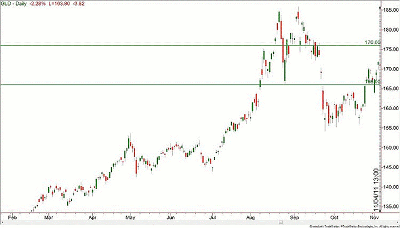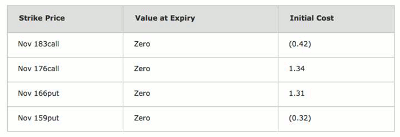This is a follow-up to my article from October 26, 2011, and I will give another example of a trade in which option position sizing was done based on the max loss of a trade. We will follow an iron condor from its inception until termination. The appropriate systematic steps, already well-known to some readers, were rigorously followed.
The first three steps were fundamental analysis (FA), technical analysis (TA), and checking implied volatility (IV). The underlying selected was the SPDR Gold Trust (GLD), the primary ETF that tracks gold.
Fundamentally, the assumption was made that the gold ETF will still be in existence even after expiration. The TA and IV analysis are closely related, so let us start with volatility first. Due to the fact that the IV reading was in the higher range, selling of premium was the optimum strategy.
At the time of entry, November 4, 2011, the weekly options were not providing a good rate of return. The weekly premium was not rich enough to be worth selling. Hence, the regular front-month options were chosen instead, which at the time had two more weeks of life.
Figure 1 below shows the daily chart of GLD with two horizontal lines representing the sold strike prices. The dotted vertical line at the far right of the chart shows the date of entry.
The next step on the list of systematic steps was correct position sizing, which in our case was only a single contract. Figure 2 shows the fifth systematic step: The entry.
NEXT: Iron Condor Entry Strategy in Detail
|pagebreak|Iron Condor Entry
GLD $170.78 on November 4, 2011:
Bear Call
- Buy to open (BTO) + 1 Nov 183 call @ - 0.42 (debit)
- Sell to open (STO) – 1 Nov 176 call @ + 1.34 (credit)
Maximum profit (Max P) (profit/reward) = + 0.92 (credit)
Maximum loss (Max L) (loss/risk):
(The formula for Max L is the width of the call strike spread minus the credit received for the bear call)
Max L (183 strike minus 176 strike = 7; 7.00 – 0.92 credit = 6.08)
Max L = 6.08
Bull Put
- STO – 1 Nov 166 put @ + 1.31 (credit)
- BTO + 1 Nov 159 put @ - 0.32 (debit)
Max P (Profit/Reward) = + 0.99 (credit)
Max L (Loss/Risk):
(The formula for Max L is the width of the put strike spread minus the credit received for the bull put)
Max L (166 put strike minus 159 put strike = 7; 7.00 – 0.99 credit = 6.01)
Max L = 6.01
The iron condor (IC) combined credit is $1.91 (or $191). This amount comes from the credit from the bull put, which was $0.99, plus the credit from the bear call of $0.92.
The maintenance held by the broker should be the greater of the two max losses, which would be the one on the bear call side.
The figure above shows the sixth step, which is exit.
Iron Condor at Expiry
GLD was at $167.65 on November 18, 2011
The figure below visually presents the fact that both the bear call as well as the bull put have expired worthless, therefore allowing us to keep the maximum premium of $191.00 without paying any additional commission.
Trading Conclusion
In conclusion, this iron condor turned out to be a “golden condor” because it achieved its max profit and no commissions were paid at the end. However, be aware that without active monitoring, it easily could have been the opposite.
If a trade is position sized based on the max loss, like this one was, with only a single contract, it is acceptable to hold it until expiry.
Had we desired to free up some of the capital used to build this iron condor on GLD prior to expiry, we could have bought to close the sold put and call legs. At that point, re-evaluation of the chart and IV could be done before entering a new iron condor using the next expiration period.
No matter what, keep your position size correct according to your risk management plan, and based on your level of tolerance and the max loss. And, of course, let the volatility be your friend, not a foe.
By Josip Causic, instructor, Online Trading Academy






















